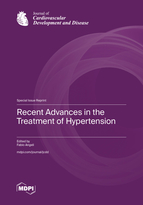Recent Advances in the Treatment of Hypertension
A special issue of Journal of Cardiovascular Development and Disease (ISSN 2308-3425).
Deadline for manuscript submissions: closed (31 January 2023) | Viewed by 52730
Special Issue Editor
2. Department of Medicine and Cardiopulmonary Rehabilitation, Maugeri Care and Research Institutes, IRCCS Tradate, 21049 Tradate, Italy
Interests: cardiovascular risk assessment in patients with hypertension; diabetes; heart failure and coronary artery disease; evaluation of cardiovascular treatment; diagnosis and treatment of acute myocardial infarction
Special Issues, Collections and Topics in MDPI journals
Special Issue Information
Dear Colleagues,
Hypertension is one of the most common cardiovascular risk factors and a leading cause of morbidity, disability, and mortality worldwide.
In the last few years, significant developments in the knowledge of basic mechanisms of hypertension and its management have been accrued. However, important differences between Guidelines for the diagnosis and treatment of hypertension exist in the classification of blood pressure levels and definition of treatment goals. Thus, efforts are still mandatory to improve treatment strategies. More specifically, we should learn more about optimal blood pressure targets to be achieved in the general hypertensive population and in specific subgroups at different cardiovascular risk.
The aim of this Special Issue is to collect reviews and original articles investigating pathophysiologic, diagnostic, and therapeutic aspects related to the management of hypertensive patients.
Prof. Dr. Fabio Angeli
Guest Editor
Manuscript Submission Information
Manuscripts should be submitted online at www.mdpi.com by registering and logging in to this website. Once you are registered, click here to go to the submission form. Manuscripts can be submitted until the deadline. All submissions that pass pre-check are peer-reviewed. Accepted papers will be published continuously in the journal (as soon as accepted) and will be listed together on the special issue website. Research articles, review articles as well as short communications are invited. For planned papers, a title and short abstract (about 100 words) can be sent to the Editorial Office for announcement on this website.
Submitted manuscripts should not have been published previously, nor be under consideration for publication elsewhere (except conference proceedings papers). All manuscripts are thoroughly refereed through a single-blind peer-review process. A guide for authors and other relevant information for submission of manuscripts is available on the Instructions for Authors page. Journal of Cardiovascular Development and Disease is an international peer-reviewed open access monthly journal published by MDPI.
Please visit the Instructions for Authors page before submitting a manuscript. The Article Processing Charge (APC) for publication in this open access journal is 2700 CHF (Swiss Francs). Submitted papers should be well formatted and use good English. Authors may use MDPI's English editing service prior to publication or during author revisions.
Keywords
- blood pressure
- hypertension
- treatment
- cardiovascular risk
- prognosis







